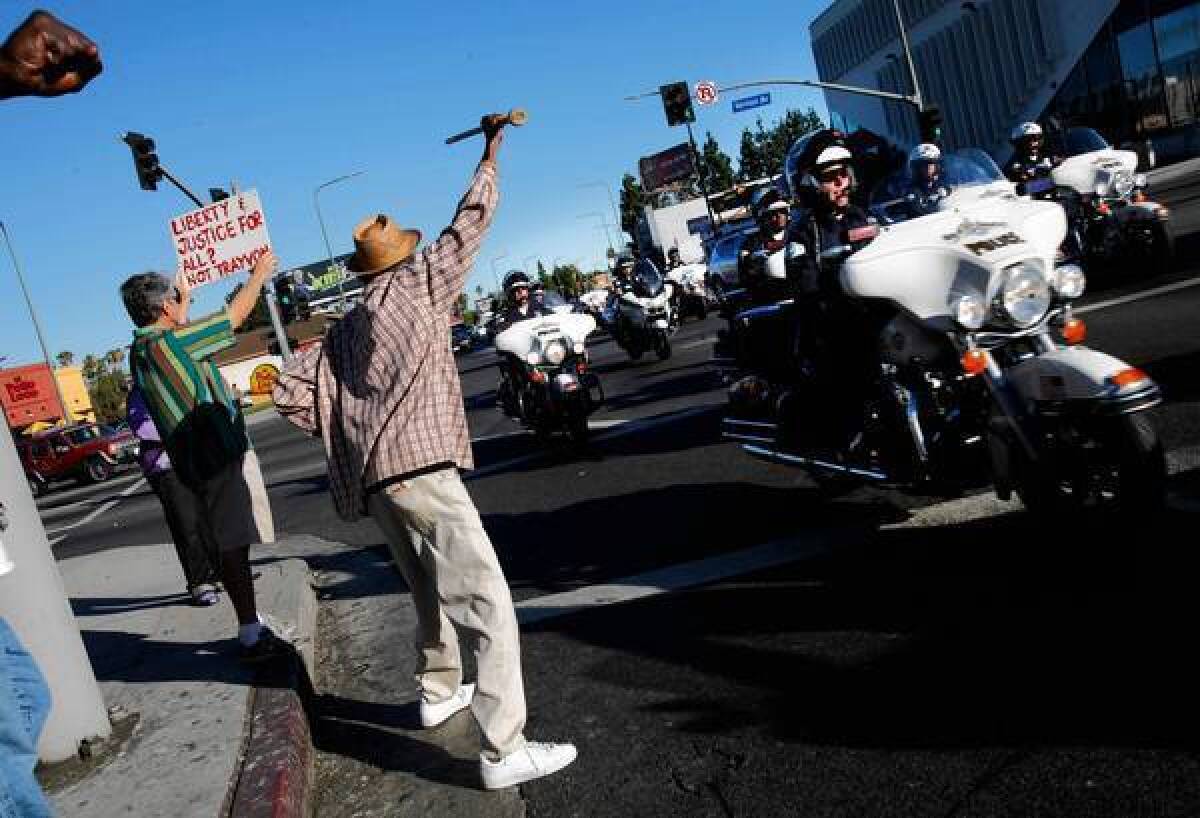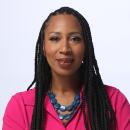LAPD praised for limited response to Zimmerman protests

- Share via
For the last few days, Los Angeles police gave demonstrators a wide berth as they protested the acquittal in Florida of former neighborhood watch volunteer George Zimmerman in the death of Trayvon Martin. They hung back when marchers blocked city streets and even shut down a major freeway.
But after a largely peaceful demonstration devolved into violence and vandalism, LAPD officials on Tuesday decided to change tactics. Images of young people storming a Wal-Mart, attacking a television crew and taunting passing motorists had city and police leaders promising a much stronger, more aggressive police response if the upheaval continues.
In recent years, the department has changed the way it handles protests; heavy-handed crowd control tactics by police cost millions in lawsuit settlements and sowed widespread distrust. The ongoing unrest over the Zimmerman case, however, underscores the difficulties the LAPD faces when confronting protesters intent on causing trouble. Police must strike a tricky balance, often under the glare of television cameras: If they take a stern, authoritarian stance to guard against the potential for violence, they run the risk of provoking an otherwise peaceful crowd. But if they are too lenient, they risk giving agitators a sense of impunity and are unprepared when things turn ugly.
During the first days of the Zimmerman protests, LAPD officers stepped in with force and arrests when protesters got out of hand, but then fell back when the protest quieted down.
Police Chief Charlie Beck on Tuesday defended the department’s handling of the protests so far, saying that his goal was to allow people to express their opinions freely.
“It’s not a mistake,” he said. “The 1st Amendment right to protest is something near and dear to all Americans. Peaceful protests should be allowed and should be facilitated…. Unfortunately, the actions of a few are going to abridge the rights of many.”
Going forward, Beck said, police would now shift to a far more strict and “very aggressive” posture toward protests. Instead of allowing marchers to spill over from sidewalks onto roadways, as they had been, he said, police would now quickly arrest protesters who disrupt traffic.
Beck added that the police presence in the Crenshaw district’s Leimert Park, a congregating area for protesters, would be significantly heavier than the 350 or so officers who were assigned there Monday.
Tuesday evening brought a new protest along Crenshaw Boulevard as well as a march through the streets of downtown Los Angeles to City Hall. Both were largely peaceful and police reported few problems. Beck actually came out from police headquarters to talk to one of the downtown protest’s organizers.
The LAPD’s response appeared more tightly organized Tuesday compared to Monday. The chief declined to provide specifics on the size of the deployment or tactics the officers would use, but several hundred officers were stationed in the area of the Los Angeles Memorial Coliseum.
Along Crenshaw Boulevard, some officers chatted with protest organizers and handed out papers stating that if any laws were broken, the LAPD would shut down the demonstration. Community volunteers were also out in force attempting to prevent problems.
John Mack, an African American civil rights figure and member of the Police Commission that oversees the LAPD, praised the police for their restraint and expressed support for Beck’s decision to clamp down. The measured response, he said, “has demonstrated again that this Los Angeles Police Department today is a 21st century Police Department.”
Mayor Eric Garcetti echoed Mack at an afternoon news conference with Beck, saying that police “created the space and the place” to allow people to vent their frustrations with the verdict. “But we also want to make sure that we maintain peace on the streets, and I thought they did an extraordinary job.”
Until recently, the LAPD had a reputation for harsh, sometimes undisciplined tactics when dealing with large, rowdy crowds. With memories of the 1992 Rodney King riots and the 2000 Democratic National Convention still very much a part of the city’s collective story line, the problem came to a head during a large pro-immigrant rally in May 2007 in MacArthur Park.
After a small group of agitators pelted officers with batteries and other objects, members of the department’s elite Metropolitan Division swept through the park indiscriminately swinging batons and firing rubber bullets to clear out the mostly peaceful protesters. Dozens of people, including a number of journalists and police officers, were injured and the city ultimately paid $13 million to settle lawsuits that arose from the clash.
After that May Day debacle, then-Police Chief William J. Bratton launched an effort to teach the LAPD’s roughly 10,000 officers a more tolerant, but not indulgent, approach to tense showdowns with unruly protesters. The effort was part of a campaign by Bratton to rebuild the department’s standing, especially in minority, poor neighborhoods.
Beck has continued Bratton’s approach and was widely applauded for the department’s deft handling of the Occupy L.A. movement in 2011.
Police largely avoided confrontations with protesters during often tense street marches and remained at the edges of the sprawling Occupy encampment that took over the lawn of City Hall for weeks.
When the decision was made to clear the camp, , police officials sneaked officers into City Hall who caught the protesters by surprise as they rushed out onto the lawn.
“It is always a balancing act,” Beck said of weighing public safety against people’s right to protest. “But public safety is always predominant.… I anticipate this Police Department will do what it does best — it will keep this city safe.… We want people to exercise their 1st Amendment, but we want them to do it responsibly.”
The department’s plans were met with mixed feelings among Crenshaw residents.
Charles Favors, 48, was one of thousands of people who took to the streets Sunday and Monday, saying that he was buoyed by the feeling of shared anger expressed peacefully. Seeing the group of largely young men turn violent Monday night disheartened Favors, but he said it was understandable.
“It’s a loaded gun when the emotional level is boiling over, then you can’t contain it,” he said. “The tension is brewing and if you add more police then it will turn it up.”
Sonja Harper, another resident, said “the police are not the big problem, even though they are intimidating,” but she worried that “their presence might drive more people to lash out.”
Times staff writers Emily Foxhall, Matthew Hamilton, Alejandro Lazo and Kate Linthicum contributed to this report.
More to Read
Sign up for Essential California
The most important California stories and recommendations in your inbox every morning.
You may occasionally receive promotional content from the Los Angeles Times.
















